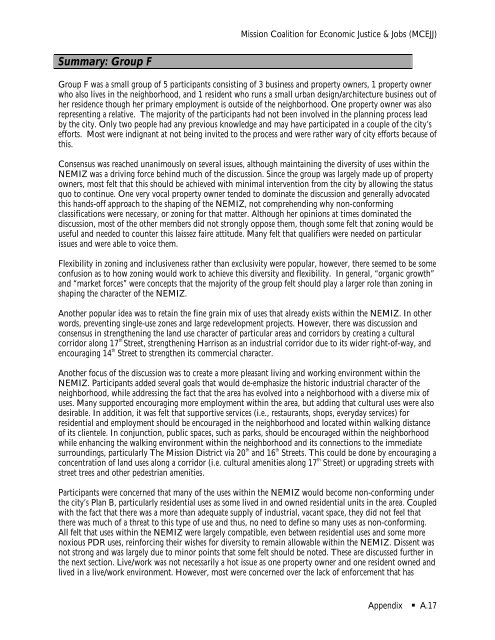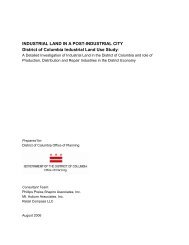An Alternative Future for the North East Mission Industrial Zone
An Alternative Future for the North East Mission Industrial Zone
An Alternative Future for the North East Mission Industrial Zone
You also want an ePaper? Increase the reach of your titles
YUMPU automatically turns print PDFs into web optimized ePapers that Google loves.
Summary: Group F<br />
<strong>Mission</strong> Coalition <strong>for</strong> Economic Justice & Jobs (MCEJJ)<br />
Group F was a small group of 5 participants consisting of 3 business and property owners, 1 property owner<br />
who also lives in <strong>the</strong> neighborhood, and 1 resident who runs a small urban design/architecture business out of<br />
her residence though her primary employment is outside of <strong>the</strong> neighborhood. One property owner was also<br />
representing a relative. The majority of <strong>the</strong> participants had not been involved in <strong>the</strong> planning process lead<br />
by <strong>the</strong> city. Only two people had any previous knowledge and may have participated in a couple of <strong>the</strong> city’s<br />
ef<strong>for</strong>ts. Most were indignant at not being invited to <strong>the</strong> process and were ra<strong>the</strong>r wary of city ef<strong>for</strong>ts because of<br />
this.<br />
Consensus was reached unanimously on several issues, although maintaining <strong>the</strong> diversity of uses within <strong>the</strong><br />
NEMIZ was a driving <strong>for</strong>ce behind much of <strong>the</strong> discussion. Since <strong>the</strong> group was largely made up of property<br />
owners, most felt that this should be achieved with minimal intervention from <strong>the</strong> city by allowing <strong>the</strong> status<br />
quo to continue. One very vocal property owner tended to dominate <strong>the</strong> discussion and generally advocated<br />
this hands-off approach to <strong>the</strong> shaping of <strong>the</strong> NEMIZ, not comprehending why non-con<strong>for</strong>ming<br />
classifications were necessary, or zoning <strong>for</strong> that matter. Although her opinions at times dominated <strong>the</strong><br />
discussion, most of <strong>the</strong> o<strong>the</strong>r members did not strongly oppose <strong>the</strong>m, though some felt that zoning would be<br />
useful and needed to counter this laissez faire attitude. Many felt that qualifiers were needed on particular<br />
issues and were able to voice <strong>the</strong>m.<br />
Flexibility in zoning and inclusiveness ra<strong>the</strong>r than exclusivity were popular, however, <strong>the</strong>re seemed to be some<br />
confusion as to how zoning would work to achieve this diversity and flexibility. In general, “organic growth”<br />
and “market <strong>for</strong>ces” were concepts that <strong>the</strong> majority of <strong>the</strong> group felt should play a larger role than zoning in<br />
shaping <strong>the</strong> character of <strong>the</strong> NEMIZ.<br />
<strong>An</strong>o<strong>the</strong>r popular idea was to retain <strong>the</strong> fine grain mix of uses that already exists within <strong>the</strong> NEMIZ. In o<strong>the</strong>r<br />
words, preventing single-use zones and large redevelopment projects. However, <strong>the</strong>re was discussion and<br />
consensus in streng<strong>the</strong>ning <strong>the</strong> land use character of particular areas and corridors by creating a cultural<br />
corridor along 17 th<br />
Street, streng<strong>the</strong>ning Harrison as an industrial corridor due to its wider right-of-way, and<br />
encouraging 14 th<br />
Street to streng<strong>the</strong>n its commercial character.<br />
<strong>An</strong>o<strong>the</strong>r focus of <strong>the</strong> discussion was to create a more pleasant living and working environment within <strong>the</strong><br />
NEMIZ. Participants added several goals that would de-emphasize <strong>the</strong> historic industrial character of <strong>the</strong><br />
neighborhood, while addressing <strong>the</strong> fact that <strong>the</strong> area has evolved into a neighborhood with a diverse mix of<br />
uses. Many supported encouraging more employment within <strong>the</strong> area, but adding that cultural uses were also<br />
desirable. In addition, it was felt that supportive services (i.e., restaurants, shops, everyday services) <strong>for</strong><br />
residential and employment should be encouraged in <strong>the</strong> neighborhood and located within walking distance<br />
of its clientele. In conjunction, public spaces, such as parks, should be encouraged within <strong>the</strong> neighborhood<br />
while enhancing <strong>the</strong> walking environment within <strong>the</strong> neighborhood and its connections to <strong>the</strong> immediate<br />
surroundings, particularly The <strong>Mission</strong> District via 20 th and 16 th Streets. This could be done by encouraging a<br />
concentration of land uses along a corridor (i.e. cultural amenities along 17 th<br />
Street) or upgrading streets with<br />
street trees and o<strong>the</strong>r pedestrian amenities.<br />
Participants were concerned that many of <strong>the</strong> uses within <strong>the</strong> NEMIZ would become non-con<strong>for</strong>ming under<br />
<strong>the</strong> city’s Plan B, particularly residential uses as some lived in and owned residential units in <strong>the</strong> area. Coupled<br />
with <strong>the</strong> fact that <strong>the</strong>re was a more than adequate supply of industrial, vacant space, <strong>the</strong>y did not feel that<br />
<strong>the</strong>re was much of a threat to this type of use and thus, no need to define so many uses as non-con<strong>for</strong>ming.<br />
All felt that uses within <strong>the</strong> NEMIZ were largely compatible, even between residential uses and some more<br />
noxious PDR uses, rein<strong>for</strong>cing <strong>the</strong>ir wishes <strong>for</strong> diversity to remain allowable within <strong>the</strong> NEMIZ. Dissent was<br />
not strong and was largely due to minor points that some felt should be noted. These are discussed fur<strong>the</strong>r in<br />
<strong>the</strong> next section. Live/work was not necessarily a hot issue as one property owner and one resident owned and<br />
lived in a live/work environment. However, most were concerned over <strong>the</strong> lack of en<strong>for</strong>cement that has<br />
Appendix A.17












